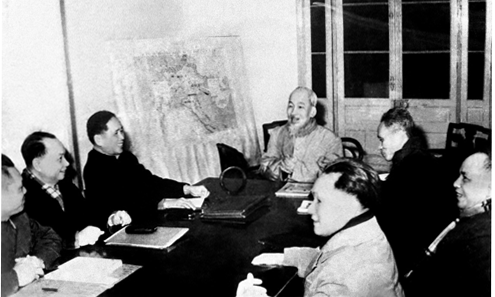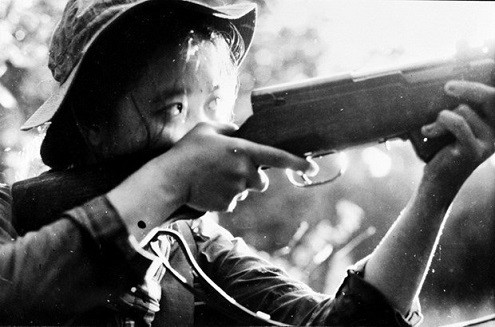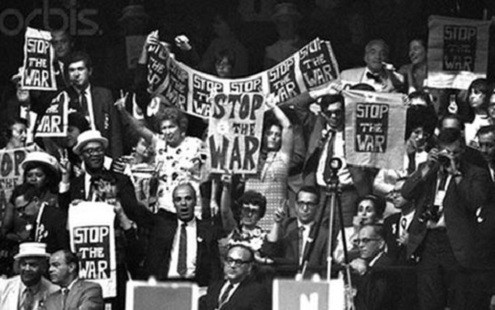(VOVWORLD) - 55 years ago, on the night of January 29 and early morning of January 30, 1968, the Vietnamese army and people launched a general offensive and uprising throughout southern Vietnam. The surprise attack hit the enemy's stronghold, demonstrating Vietnamese people's strategic thinking, bravery, intelligence and aspiration for peace, independence and reunification.
 The Politburo, the Central Committee of the Labor Party of Vietnam convened to discuss the launch of the 1968 Tet Offensive (file photo: dangcongsan.vn) The Politburo, the Central Committee of the Labor Party of Vietnam convened to discuss the launch of the 1968 Tet Offensive (file photo: dangcongsan.vn) |
The success of the 1968 General Offensive changed the complexion of the war waged by the US military in Vietnam and induced the US to begin negotiating with north Vietnam at the Paris Conference. In 1973, the US unilaterally withdrew its troops from Vietnam creating a prerequisite for national reunification of the Vietnamese people.
 Dau Tieng guerilla in the 1968 Tet Offensive (File photo: VNA) Dau Tieng guerilla in the 1968 Tet Offensive (File photo: VNA) |
Changing the complexion of the war
The 1968 General Offensive and Uprising took place with the US and the Sai Gon administration holding the stronger forces on the battlefield. By attacking and revolting simultaneously, boldly targeting urban areas, the Vietnamese army and people struck a decisive blow to Americans’ certainty about the war’s outcome and began what would prove to be a long, gradual withdrawal by the US military.
Lieutenant General Nguyen Van Bao, Director of the Academy of Politics under the Ministry of Defense, said: "The Communist Party of Vietnam decided to launch the offensive on the occasion of the Lunar New Year, right on New Year's Eve, when the enemy was not prepared. The enemy was completely shocked by our attack. They were shocked by the time of the attack, its targets which were urban areas and major bases, and also by the scale of the attack, which took place throughout out the south at the same time."
Creating a major change in perception of the war was the biggest and most important result of the 1968 Tet Offensive. It was a turning point in the war, exposing as it did the failure of the US’s "local warfare" strategy and demonstrating the strength of the people’s war in southern Vietnam.
The Operation manifested the Communist Party of Vietnam’s spirit of independence, self-reliance, creativity, and outstanding war tactics in seizing an opportunity to change the war situation by mobilizing the force and wisdom of the Vietnamese people.
 Movements to protest the war in Vietnam before the National Congress of the Democratic Party in Chicago in 1968 (Photo: Arthur Rothstein) Movements to protest the war in Vietnam before the National Congress of the Democratic Party in Chicago in 1968 (Photo: Arthur Rothstein) |
Acknowledgement from the other side
In his 1972 memoir entitled “The vantage point”, US President Lyndon B. Johnson admitted anticipating a show of force but it turned out to be much more massive than expected. The attack hit many targets and was coordinated across South Vietnam. Johnson said nobody expected that the attack would be launched during Vietnam’s sacred holiday. Michael Maclear, author of “The Ten Thousand Days War”, admitted that the Vietnam War had many surprises, but none more shocking than the Tet offensive.
Nathaniel James, a peace activist said that the anti-war movement was growing quickly in the US but exploded after the 1968 Tet Offensive, which showed that the war in Vietnam was a losing proposition for the Americans.
Colonel Charles Krohn, an American veteran spy and author of a book about Hue during the 1968 Tet Offensive said the operation held strategic significance because it reduced Americans’ support for the war in Vietnam. It was a big loss for the US and one of the decisive events of the war.
Although the US didn’t complete its troop withdrawal from southern Vietnam until 5 years after the 1968 Tet Offensive and the Saigon regime didn’t collapse until 7 years after, strategically, the US lost the game in the spring of 1968. 55 years after the General Offensive and Uprising, the bravery, intelligence and determination of the Vietnamese army and people on their path to national independence and reunification have become clearer.
According to Associate Professor. Dr. Nguyen Van Sau, Deputy Director of the Institute of Military History, during the 1968 Tet Offensive, the Vietnamese army and people attacked 4 of 6 major cities, 37 of 44 towns, hundreds of townships and districts, and several enemy military bases. The General Offensive routed 150,000 enemy troops, and liberated 100 and more than 1.6 million people.